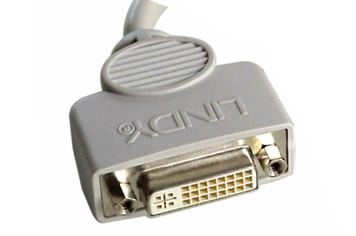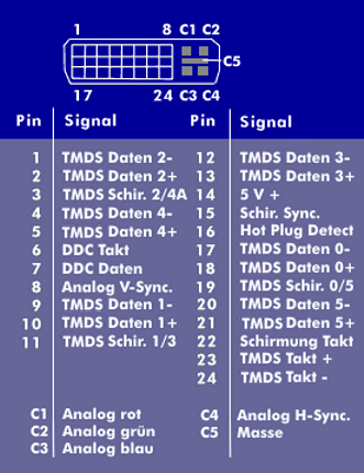digital visual interface (DVI)
Digital Visual Interface(DVI) is a digital display interface for connectingLCD and TFT displays, projectors, large screens, plasma displays or cameras, but also consumer electronics devices such as TVs or DVD players. This digital interface facilitates adaptation because clock and phase adjustments are no longer necessary.
DVI interface with TMDS
The DVI interface was developed by the Digital Display Working Group (DDWG), which includes well-known manufacturers such as Compaq, Intel, IBM, HP and NEC. Data is transferred via the panel link with a total of six channels, providing a data rate of 3.7 Gbit/s. This results in a datatransferrate of up to 1.5 Gbit/s, depending on the screen resolution. Depending on the refresh rate, this results in a resolution of up to Quadruple-XGA( QXGA) with 2,048 x 1,536 pixels with color depths of 12 bits and 24 bits. This means that this interface supports all VGA versions and high-definition television( HDTV). The DVI interface is compatible with Plug and Display(PnD) and Digital Flat Panel( DFP). As copy protection, the DVI interface uses High-Bandwidth Digital Content Protection( HDCP) to encrypt data transmission between the graphics card and the display.
The connection types of the DVI interface
DVI technology distinguishes between two connection types: single-link and dual-link. The mentioned data rate of 3.7 Gbit/s refers to a single-link connection, the data rate for dual-link is 7.4 Gbit/s. The DVI interface can be used in PC technology and also in consumer electronics. Therefore, there are several DVI connector designs. A distinction is made between digital, analog and combined DVI connectors.
DVI-D : The digital connector is the DVI-D connector with 24 pins. With this DVI connector, only digital signals can be transmitted between digital video sources and monitors. DVI-D uses Transition Minimized Differential Signaling( TMDS) as the transmission method. The transmission can be done via Single-Link and Dual-Link. Single-Link uses three wire pairs for data transmission and has a maximum data rate of 3.72 Gbps. In Single-Link, TMDS can be used to connect displays with a resolution of 1,920 x 1,200 pixels at a refresh rate of 60 Hz. Dual-Link has six wire pairs and a maximum data rate of 7.44 Gbit/s for displays with a resolution of 2,560 x 1,600 pixels. Dual-Link can also be used to display stereoscopic 3D displays with shutter glasses.
DVI-A : The DVI-A connector is an analog connector that is used when an analog controlled display is used. With the 29- pin DVI-A connector, the color signals for red (R), green (G) and blue (B) sync signals are transmitted via the five C-connector contacts. DVI-A is compatible with analog video signals.
DVI-I: DVI-I is an integrated connector that supports both digital and analogRGB signals, making it compatible with analog monitors. With this interface, which is available for single-link and dual-link, the analog signals are transmitted via the five contacts marked with "C".
The DVI connector is also available as Mini-DVI and Micro-DVI. However, these are Apple-specific versions.
The DVI connection cable can have a length of about 3 m to 5 m as a non-shielded cable. If it is shielded, then it can be about 7 m long.


